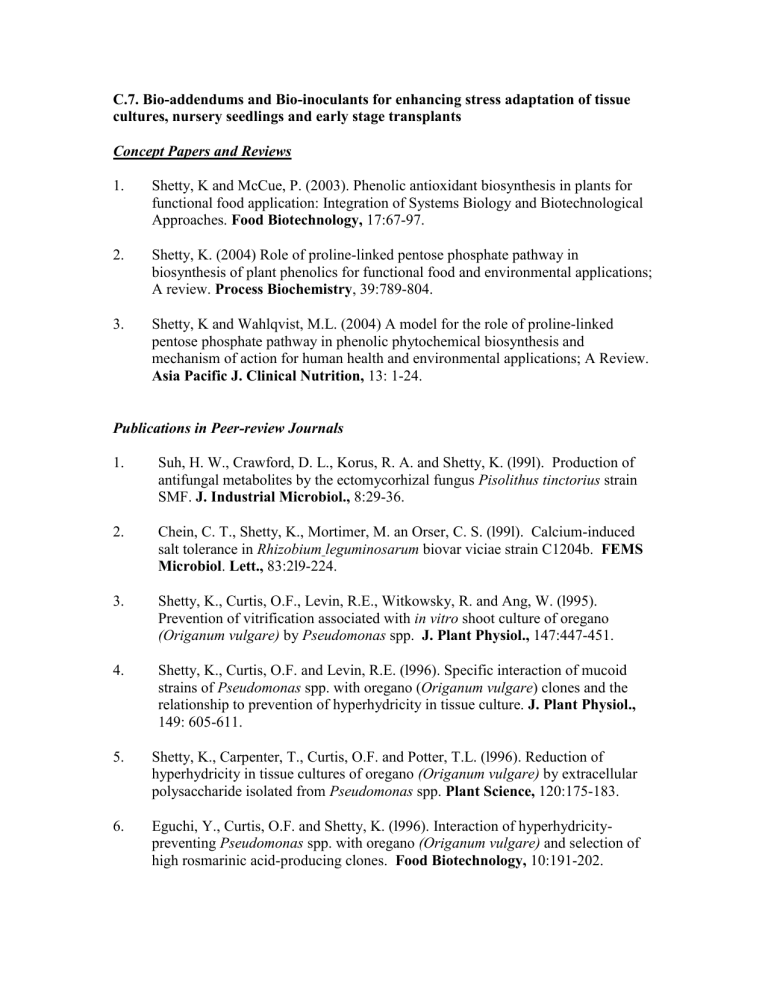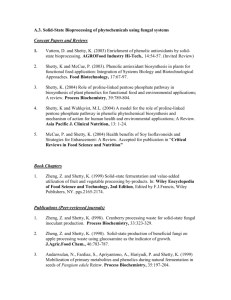C.7. Bio-addendums and Bio-inoculants for enhancing stress

C.7. Bio-addendums and Bio-inoculants for enhancing stress adaptation of tissue cultures, nursery seedlings and early stage transplants
Concept Papers and Reviews
1. Shetty, K and McCue, P. (2003). Phenolic antioxidant biosynthesis in plants for functional food application: Integration of Systems Biology and Biotechnological
Approaches. Food Biotechnology, 17:67-97.
2. Shetty, K. (2004) Role of proline-linked pentose phosphate pathway in biosynthesis of plant phenolics for functional food and environmental applications;
A review. Process Biochemistry , 39:789-804.
3. Shetty, K and Wahlqvist, M.L. (2004) A model for the role of proline-linked pentose phosphate pathway in phenolic phytochemical biosynthesis and mechanism of action for human health and environmental applications; A Review.
Asia Pacific J. Clinical Nutrition, 13: 1-24.
Publications in Peer-review Journals
1. Suh, H. W., Crawford, D. L., Korus, R. A. and Shetty, K. (l99l). Production of antifungal metabolites by the ectomycorhizal fungus Pisolithus tinctorius strain
SMF. J.
Industrial Microbiol., 8:29-36.
2. Chein, C. T., Shetty, K., Mortimer, M. an Orser, C. S. (l99l). Calcium-induced salt tolerance in Rhizobium leguminosarum biovar viciae strain C1204b. FEMS
Microbiol . Lett., 83:2l9-224.
3. Shetty, K., Curtis, O.F., Levin, R.E., Witkowsky, R. and Ang, W. (l995).
Prevention of vitrification associated with in vitro shoot culture of oregano
(Origanum vulgare) by Pseudomonas spp. J. Plant Physiol., 147:447-451.
4. Shetty, K., Curtis, O.F. and Levin, R.E. (l996). Specific interaction of mucoid strains of Pseudomonas spp. with oregano ( Origanum vulgare ) clones and the relationship to prevention of hyperhydricity in tissue culture. J. Plant Physiol.,
149: 605-611.
5. Shetty, K., Carpenter, T., Curtis, O.F. and Potter, T.L. (l996). Reduction of hyperhydricity in tissue cultures of oregano (Origanum vulgare) by extracellular polysaccharide isolated from Pseudomonas spp. Plant Science, 120:175-183.
6. Eguchi, Y., Curtis, O.F. and Shetty, K. (l996). Interaction of hyperhydricitypreventing Pseudomonas spp. with oregano (Origanum vulgare) and selection of high rosmarinic acid-producing clones. Food Biotechnology, 10:191-202.
7. Ueno, K. and Shetty, K. (l997). Effect of selected polysaccharide-producing soil bacteria on hyperhydricity control in oregano tissue cultures. Applied
Environmental Microbiol., 63:767-770.
8. Zheng, Z. and Shetty, K. (l998). Cranberry processing waste for solid-state fungal inoculant production. Process Biochemistry, 33:323-329.
9. Zheng, Z. and Shetty, K. (1998). Solid-state production of beneficial fungi on apple processing waste using glucosamine as the indicator of growth.
J.Agric.Food Chem., 46:783-787.
10. Ueno,K., Cheplick,S. and Shetty, K. (1998) Reduced hyperhydricity and enhanced growth of tissue culture-generated raspberry ( Rubus sp.) clonal lines by
Pseudamonas sp. isolated from oregano. Process Biochemistry, 33:229-238.
11. Ueno,K. and Shetty, K. (1998) Prevention of hyperhydricity in oregano shoot cultures is sustained through multiple subcultures by selected polysaccharideproducing soil bacteria without re-inoculation. Appl.Microbiol.Biotechnology,
50:119-124.
12. Bela, J., Ueno, K. and Shetty, K. (l998). Control of hyperhydricity in anise
( Pimpinella anisum ) tissue cultures by Pseudomonas spp. J. Herbs, Spices and
Medicinal Plants, 6:47-57.
13. Zheng, Z. and Shetty, K. (1999) Effect of apple pomace-based Trichoderma inoculants on seedling vigor in pea ( Pisum sativum ) germinated in potting soil.
Process Biochemistry, 34:731-735.
14. Perry, P., Ueno, K. and Shetty, K. (1999) Reversion to hyperhydration by addition of antibiotics to remove Pseudomonas in unhyperhydrated oregano tissue cultures.
Process Biochemistry, 34:717-723.
15. Andarwulan, N. and Shetty, K. (1999) Improvement of pea ( Pisum sativum ) seed vigor by fish protein hydrolysates in combination with acetyl salicylic acid.
Process Biochemistry, 35:159-165.
16. Eguchi,Y., Milazzo,M.C.,Ueno,K. and Shetty,K. (1999) Partial improvement of vitrification and acclimation of oregano ( Origanum vulgare ) tissue cultures by fish protein hydrolysates. J. Herbs, Spices and Medicinal Plants, 6:29-38.
17. Andarwulan, N. and Shetty, K. (1999) Influence of fish protein hydrolysates in combination with acetyl salicylic acid on hyperhydricity reduction and phenolic synthesis in oregano ( Origanum vulgare ) tissue cultures. J. Food Biochemistry,
23:619-635.
18. McCue,P., Zheng,Z., Pinkham.J.L. and Shetty,K. (2000) A model for enhanced pea seedling vigor following low pH and salicylic acid treatments. Process
Biochemistry, 35:603-613 .
19. Zheng. Z. and Shetty, K. (2000) Enhancement of pea ( Pisum sativum ) seedling vigor and associated phenolic content by extracts of apple pomace fermented with
Trichoderma spp. Process Biochemistry, 36:79-84 .
20. Shetty, P., Atallah, M.T. and Shetty, K. (2001) Enhancement of total phenolic, L-
DOPA and proline contents in germinating fava bean( Vicia faba ) in response to bacterial elicitors. Food Biotechnology, 15:47-67.
21. Duval, B. and Shetty K. (2001) The stimulation of phenolics and antioxidant activity in pea ( Pisum sativum ) elicited by genetically transformed anise root extract. J.Food Biochemistry, 25:361-377
22. Shetty, P., Atallah, M.T. and Shetty, K. (2002) Effects of UV treatment on the proline-linked pentose phosphate pathway for phenolics and L-DOPA synthesis in dark germinated Vicia faba . Process Biochemistry, 37: 1285-1295.
23. Vattem, D.A. and Shetty, K. (2002) Solid-state production of phenolic antioxidants from cranberry pomace by Rhizopus oligosporus . Food Biotechnology, 16:189-
210.
24. Randhir, R. and Shetty, K. (2003) Light-mediated fava bean ( Vicia faba ) response to phytochemical and protein elicitors and consequences on nutraceutical enhancement and seed vigor. Process Biochemistry, 38: 945-952.
25. Shetty, P., Atallah, M.T. and Shetty, K. (2003) Stimulation of total phenolics, L-
DOPA and antioxidant activity through proline-linked pentose phosphate pathway in response to proline and its analog in germinating fava beans ( Vicia faba )
Process Biochemistry, 38: 1707-1717.
26. Vattem, D.A. and Shetty, K. (2003) Ellagic acid production and phenolic antioxidant activity in cranberry pomace mediated by Lentinus edodes using solidstate system. Process Biochemistry, 39: 367-379.
27. Randhir, R. and Shetty, K. (2004) Microwave-induced stimulation of L-DOPA, phenolics and antioxidant activity in fava bean ( Vicia faba ) for Parkinson's diet.
Process Biochemistry, In press.
28. Correia, R.T.P., McCue, P., Margarida, M.A.M., Macedo, G.R. and Shetty,K
(2004) Production of phenolic antioxidants by solid-state bioconversion of pineapple waste mixed with soy flour using Rhizopus oligosporus . Process
Biochemistry, In press.
29. Correia, R.T.P., McCue, P., Margarida, M.A.M., Macedo, G.R. and Shetty,K
(2004) Solid-state bioconversion of guava waste mixed with soy flour using
Rhizopus oligosporus to enhance phenolic antioxidants. J. Food Biochemistry,
Accepted for Publication .
30. Randhir, R., Lin, Y-T. and Shetty, K. (2004) Phenolics, antioxidant and antimicrobial activity in dark germinated fenugreek sprouts in response to peptide and phytochemical elicitors. Asia Pacific Journal of Clinical Nutrition,
Accepted for Publication .







